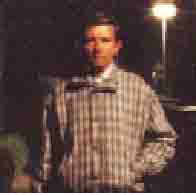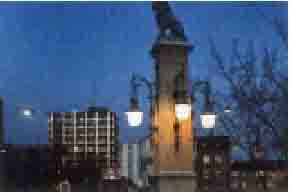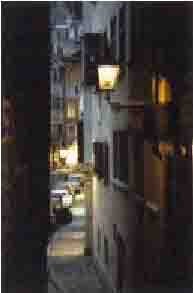U.S. Department of Transportation
Federal Highway Administration
1200 New Jersey Avenue, SE
Washington, DC 20590
202-366-4000
The term high-mast lighting generally refers to a group of luminaires mounted at a height of 20 m or more. Its use in interchange lighting leaves the area free of poles and provides motorists with an uncluttered view of the interchange. With careful pole placement, glare is much less of a problem than in conventional lighting. In addition, maintenance can usually be done without disturbing the traffic flow.
In Finland, the panel was shown a nearly completed interchange that was lit with asymmetric floods mounted on high-mast poles. The lighting on that interchange was installed before construction was completed, thereby making it possible to continue work on the interchange after dark (figure 35).
Figure 35. High-mast lighting, Finland (inset, close-up of luminaire).
Belgium has several existing interchanges using poles up to 35 m in height (figure 36), but does not have any new high-mast installations. Existing interchanges use either HPS sources, in 400 to 1,000 watt, or 131- to 180watt LPS, with an asymmetrical photometric distribution.
Figure 36. High-mast lighting, Belgium.
Other than in Finland and Belgium, the panel did not observe any new high-mast installations. The French indicated that high-mast lighting was used quite a lot in the 1970s and '80s, but is not currently used.
The illuminance design technique is used to light residential, small town, intersection, and conflict areas. The new urban lighting trend in Europe is the use of indirect lighting. Several examples of decorative lighting are shown in figures 37 through 46.
Figure 37. Parking lot lighting, Helsinki, Finland.

Figure 38. Parking lot lighting, Helsinki Airport, Finland.

Figure 39. To aid recognition, vertical and semispherical illuminance is used in pedestrian areas.

Figures 40a, b, & c. Examples of typical decorative lighting in Zurich, Switzerland.


Figures 41. Downtown Helsinki, Finland.
Figures 42. Downtown Helsinki, Finland.
Figures 43. Decorative lighting in Finland.
Figures 44. Decorative lighting in Finland (inset, detail of luminaire).
Figures 45. Zurich, Switzerland, at night.
Figures 46. Zurich, Switzerland, at night.
In Finland and Switzerland, overhead, directional signs are currently lit with top-mounted luminaires. To save money, however, the Finns are moving away from sign lighting by using micro-prismatic sheeting material. In France, engineering-grade, retroreflective material has been used, and the French also are moving away from fixed sign lighting.
Figure 47. Micro-prismatic sheeting material for signs in Finland.
The panel recommends the use of micro-prismatic sheeting materials for unlighted signs mounted overhead and on the left shoulder.
| << Previous | Contents | Next >> |